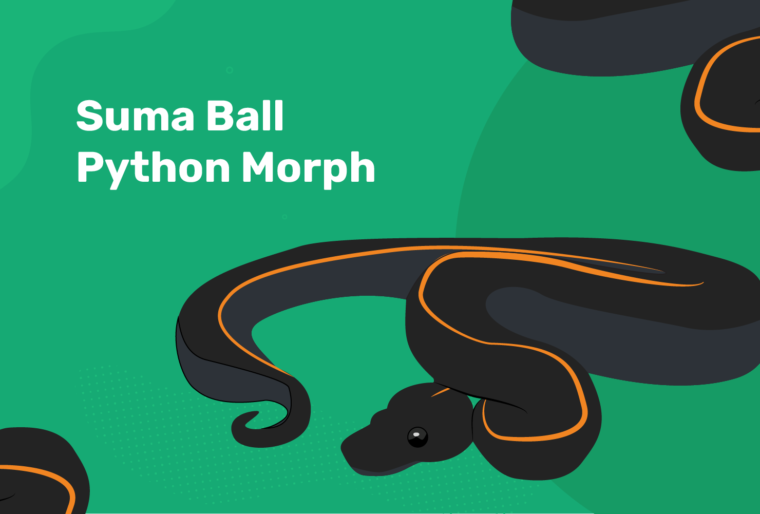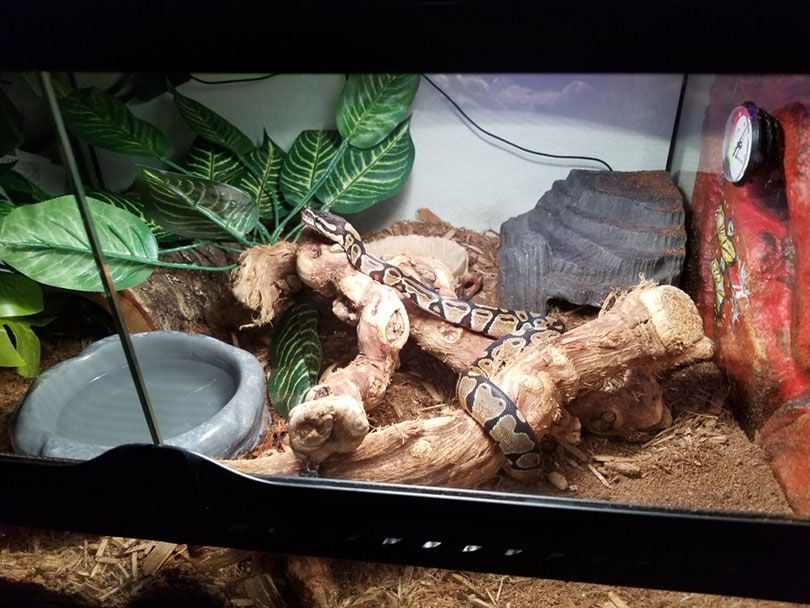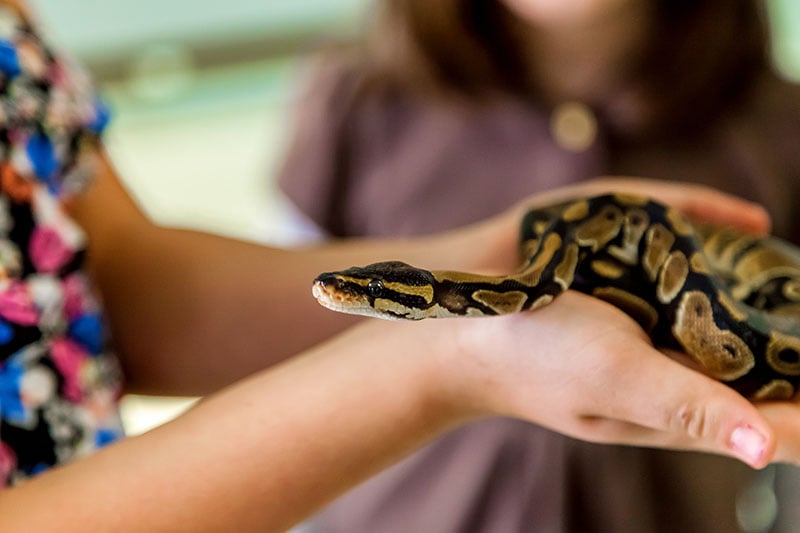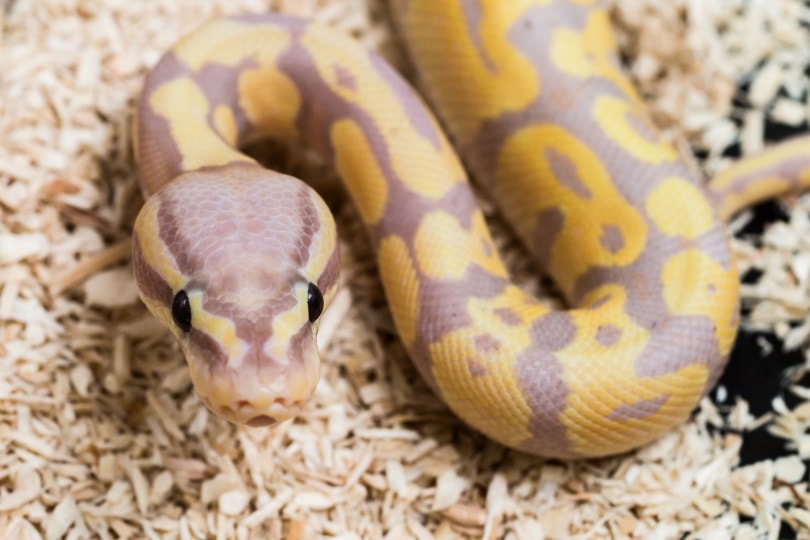
Ball pythons are native to Central and Western Africa and have become increasingly popular pets. They are easy to handle, have long life spans, and come in a variety of morphs (colors and patterns not produced in nature.)
The Suma Ball Python or Super Mahogany Ball Python is a morph that was initially produced in 2009. The Suma morph is produced by two copies of the co-dominant Mahogany gene.
When two Mahogany morphs are bred, 25% of their offspring will be the Suma morph. This morph can be variable but generally have a dark to black, patternless appearance with a copper-colored line down the body. Suma’s can also be jet black or have more copper coloration all over the body.

Quick Facts about Suma Ball Python Morph
| Species Name: | Python Regius |
| Common Name: | Ball Python, Royal Python |
| Care Level: | Beginner |
| Lifespan: | Up to 30 years |
| Adult Size: | 2-4ft (Males) 3-6ft (Females) |
| Diet: | Mice, Rats |
| Minimum Tank Size: | 30 Gallon Vivarium (Adult) |
| Temperature & Humidity | 85-91°F (Hot Side) 75-80°F (Cool Side)
55-60% Humidity |
Do Suma Ball Python Morphs Make Good Pets?
The Suma Ball Python will make a great pet for even first-time snake owners. They are docile, handleable, and easy to care for. These snakes are typically shy as babies but become increasingly more engaging as they age.
The Suma Ball Python will have a lifespan of up to 30 years with proper husbandry and are generally inexpensive to keep once you get past the cost of initial setup.
Appearance
The Suma Ball Python morph has a dark and patternless appearance. The coloration of the Suma morph can vary.
Most Sumas are very dark with a copper-colored line down the center of the body. Occasionally they will be produced with the copper coloration expanding beyond their center. The Suma morph can also be pure jet black.

How to Take Care of Suma Ball Python Morph
Habitat, Tank Conditions & Setup
The Suma Ball Python Morph is a cold-blooded reptile that has certain requirements when it comes to its habitat and care. Let us take a look at what you’ll need to help your snake thrive!
Tank
Your Suma Ball Python will require a well-ventilated and secure enclosure. The vivarium can be glass or plastic. You will need to supply two hides inside the enclosure, one for the hot side and another for the cool side. They will always need a fresh bowl of water available.
You should start with a 10-to-20-gallon vivarium for a hatchling. They will feel safer in the smaller enclosure, and this will prevent unnecessary stress.
As juveniles, they can be housed in a 20-gallon or larger enclosure. An adult ball python should have a 30-to-40-gallon enclosure.
Lighting
Ball pythons do not require any special lighting such as UVB like other reptiles. You will want your natural room lighting to mimic normal day-night cycles.
If your Ball Python’s room is exceptionally dark during daylight hours, you should consider keeping the light on during the day and shutting it off at night.
Heating (Temperature & Humidity)
Temperature and humidity levels are especially important for the overall health of your Suma Ball Python. In terms of temperature, you will need to have a dedicated hot and cool side in your snake’s enclosure. You will want to ensure there is a hide available on each side. Heating tape or a heating mat is ideal for Ball Pythons and can be installed to heat a specific area of the tank.
The hot side should be between 85-91°F and should never exceed 93°F. The cool side should be about 80°F and never below 75°F. The average ambient, or overall temperature of the enclosure should be around 82°F.
To ensure your temperatures are correct in your Suma Ball Python’s enclosure you will want to purchase thermometers. It’s best to have two thermometers so that you can measure temperature on both the hot side and cool side.
As for humidity, Ball Pythons require 55 to 60% humidity in their enclosure. This humidity level allows the snake to keep their skin moist enough to shed properly. Maintaining proper humidity levels will also help prevent respiratory infections and other illnesses.
You can purchase an instrument called a hygrometer to measure the humidity in the enclosure. Hygrometers are generally very inexpensive.
Substrate
You will want to ensure you have the proper bedding in your Suma Ball Python enclosure. You can use substrates such as fir bark, coconut husk, and aspen bedding.
Some great products with these substates include Repti Bark, Reptile Prime, Repti Chip, and Aspen Snake Bedding. You will never want to use cedar substrate or sand in your Ball Python’s enclosure.
| Tank Recommendations | |
| Tank Type | 40-gallon glass or plastic vivarium |
| Lighting | N/A |
| Heating | Heating pad/tape on the bottom of the enclosure |
| Best Substrate | Aspen bedding, Coconut Husk, Fir Bark |
Feeding Your Suma Ball Python Morph
Suma Ball Pythons are constrictors that consume their prey whole. They will need to feed on appropriately sized mice or rats. The size of its prey should be approximate to the width of the snake at the largest part of its body. They can be fed live, freshly killed, or frozen-thawed mice or rats.
Live rodents can inflict serious injury to a snake. If you choose live feeding, the snake will need to be supervised during the feeding process to avoid injury.
Young ball pythons should be fed once weekly. Adult ball pythons over three years of age typically eat once every two to three weeks. The frequency of adult feeding is dependent on the size of the food item, the time of year, and reproductive activity. Feeding too frequently can lead to obesity.
Ball pythons are known for being finicky eaters. Any feeding concerns should be addressed with your veterinarian.
| Diet Summary | |
| Fruits | 0% of diet |
| Insects | 0% of diet |
| Meat | 100% of diet – appropriately sized rodents |
| Supplements Required | N/A |
Keeping Your Suma Ball Python Morph Healthy
Suma Ball Python Morphs are generally healthy snakes with proper husbandry. However, there are some medical conditions that you should be on the lookout for. If your snake exhibits any unusual symptoms, you will need to seek veterinary care as soon as possible.
Lifespan
With proper care, your Suma Ball Python Morph can live anywhere from 20 to 30 years. In rare cases, Ball Pythons have been recorded living past 40 years of age.
Breeding
The breeding season for a Suma Ball Python Morph is primarily from mid-September through mid-November. Females will generally lay 1 to 11 eggs per clutch.
The females reach reproductive maturity around 27 months of age. Males reach their maturity much sooner, between 16 and 18 months of age.
The visually dominant traits of the Suma Ball Python Morph will appear when breeding. There is a vast variety of Ball Python morphs in the pet trade today, these genetics can be combined with a variety of others.

Are Suma Ball Python Morphs Friendly? Our Handling Advice
After bringing home your new Suma Ball Python Morph, you will want to avoid handling it for the first several days and up to two weeks to allow it to settle into the new habitat.
Ball Pythons are very docile snakes. They do not require social interaction for their mental health so frequent handling is not necessary. Handling your snake multiple times in a day can cause it stress. It’s generally recommended to handle 1-2 times weekly to keep your snake tame.
Snakes tend to bite when you are being mistaken for food or are causing them to feel threatened. Always wash your hands and observe your snake’s body language before handling.
Shedding & Brumation: What to Expect
Your Suma Ball Python Morph will be shed multiple times throughout its life. Younger snakes shed more often as they grow.
The scales will look dull, and the eyes will start to look blue when your snake is getting ready to shed. It’s normal for your Ball Python to refuse meals close the time.
The proper humidity level is vital for shedding. You can even raise the humidity in the enclosure slightly to help ensure a successful, complete shed.
Ball pythons do not brumate. It is not unusual for adult ball pythons to eat much less or not eat at all during the winter months. Generally, they will pick feeding back up in late winter or early spring. Any concerns should be discussed with a veterinarian.
How Much Do Suma Ball Python Morphs Cost?
Suma Ball Python Morphs typically cost anywhere from $2000 to $3000. The ball python pet trade is constantly producing new morphs, prices tend to decrease once the breeding of a certain morph has been well established.
You will want to set aside anywhere from $150 to $500 for the initial setup costs for your snake to ensure their overall health and wellbeing.
Care Guide Summary

Conclusion
If you are looking for a snake that breaks the common pattern of a normal Ball Python and takes on a darker look, the Suma Ball Python Morph may be the snake for you.
This is a generally docile and unique snake that would be a good choice for beginners up to the most experienced snake enthusiasts.
- Related Article: Do Ball Pythons Make Good Pets?
Featured Image Credit: PetKeen.com








